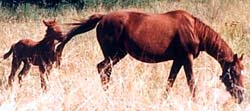 The efforts of horse owners should be praised, even though there has been a spread of infection of horses with Equine Influenza (EI) virus within infected areas, according to Charles Sturt University (CSU) veterinary science lecturer Dr Sharanne Raidal.
The efforts of horse owners should be praised, even though there has been a spread of infection of horses with Equine Influenza (EI) virus within infected areas, according to Charles Sturt University (CSU) veterinary science lecturer Dr Sharanne Raidal.
The NSW Department of Primary Industry (DPI) is maintaining quarantine restrictions as well as a ban on horse movements to stem the advance of the Equine Influenza (EI) virus and “the Department is urging continued vigilance as plans are unveiled to import an EI vaccine”, she said.
Dr Raidal says, however, that “two disturbing claims are being made by horse owners or their connections which need clarification”.
“The first is that the cost of quarantine is greater than the cost of allowing the disease to become endemic. Equine influenza is endemic in most countries in the world and causes significant illness in all horse breeds. Examination of how the disease affects horses and their owners in these countries reveals what we could expect in Australia if EI is not successfully eradicated.
“Despite vaccination, the virus can ‘cycle’ through the horse population, causing subclinical infection and periodically changing to induce more serious disease and to evade vaccination. The cost to Australia of giving up on eradication attempts would be an ongoing cycle of disease outbreaks. In good years this would result in sub-clinical infection and poor performance in vaccinated horses, with a few horses, such as foals, becoming more severely affected.

“In bad years disease would result in serious disease in vaccinated and unvaccinated horses, so that race tracks may be closed and other competitions postponed or abandoned. Large numbers of horses would have extensive time convalescing from disease; some affected horses would die or succumb to secondary effects of the disease.”
Dr Raidal said that second disturbing claim is that vaccination is able to prevent disease.
Dr Raidal stresses, “Vaccination does not prevent infection or disease - it just makes it a little less severe and decreases the amount of virus being shed. We can't rely on vaccination to prevent or contain spread of the virus and it can’t be relied on to keep individual horses healthy. The infection of vaccinated stallions currently in quarantine at Eastern Creek demonstrates this point.
“If the virus is not contained, vaccination would be something that we would all be doing every four to six months, to try to reduce the severity of disease in our own horses. The annual cost of vaccination would be in excess of $100 per horse.
“In our current situation, vaccination may have a role in final eradication of the disease, however there are a number of very significant problems with vaccination, not the least of which is that vaccine has limited efficacy as it induces only partial immunity and short-term protection.
“Initial vaccination requires at least two doses of vaccine given at least two weeks apart, hence there is a considerable delay between vaccination and any benefit. If vaccination is used, it must be in conjunction with ongoing attempts to physically contain the disease.
"Current efforts to limit the spread of virus by movement restrictions and strict hygiene measures must be maintained," Dr Raidal said.





Social
Explore the world of social